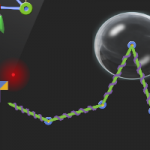
PRQ: FreeFall

PRQ: FreeFall
I purposely hid that information from you. And if you look at the value of y when the spuCraft is near the bridge, you’ll see that I really went out of my way to hide that information from you.
I don’t want you to use the bridge height… so you can’t. And you don’t need it.
Think about the Lift challenge. In Lift, Pokey starts from rest then falls because of gravity. Then, a short time into the fall, it gets a net constant upward force, which slows down the descent and eventually turns the spuCraft around. To solve that problem, you did not need to know the initial height of Pokey. You could use the height and velocity of the spuCraft at some point along the way. Right?
If you think about it, the trajectory of the spuCraft in FreeFall is very similar. Just like lift, I’m not giving you the initial height of the spuCraft. I am giving you the (current) height and velocity of the spuCraft at all points along its trajectory, after it has moved a certain distance from the bridge.
Nope. All you need to know that it is always possible (barely) to land.
Instead of thinking about how to get past a portion of the domain before the gate does, I suggest that you ignore the gate and just think about how to get to the bottom (safely) as soon as possible. If you get to the bottom in as little time as possible, you are guaranteed to get past the gate.
Getting past the gate and not crashing on the landing pad is the hard part. The rest is easy.
You do NOT have to write scripts that automatically land the spuCraft. It is so much simpler to define a switch that will return to manual control. Then you can land by hand.
The way I solve the problem is to use the positions and velocities at the two points to calculate Fb. After that, the solution is identical to Novice.
Wily is very similar to Rookie, but the differences are important.
In the Intermediate level, you no longer have access to the buoyancy force, Fb. But in instead, you get position and velocity from another point on its path.
Can you think about how you can use this information to replace the old information you lost? Think about it!
If you’re still stuck, you can click here.
The latching condition is quite sensitive. Although it may appear that the payload is in the right place at the right time, it needs to be almost exact for the latch to occur.
The thing to note here is that when you tell the platform to go to a specific height, it doesn’t get there instantaneously. It takes a little time. Also, it takes a little time to come to a complete stop. To ensure that you have plenty of time to get the platform to the right place and bring it to a complete stop, I suggest the following things to avoid:
In a previous version of Spumone, this was a problem. I think I fixed it. If you have this problem, please let me know.
You only have control of the platform height. In general, you do not have control over the platform speed. The only instance for which you have control of the platform speed is when the platform speed is ZERO.
So instead of trying to make the speed of the platform match the speed of the spuCraft, maybe you should think about the speed of the spuCraft matching the speed of the platform.
Next, I would suggest that you make a list of the quantities in the problem that you know, and those that you want to know.
In particular, you should look at what we call the boundary conditions. Answer the following questions:
What are the forces acting on the spuCraft between the light gate and the payload latch? Given this, how can you use Newton’s Second Law or the Work-Energy Principle to relate the boundary conditions. In particular, you need to relate the the things you want to know to the things you know.